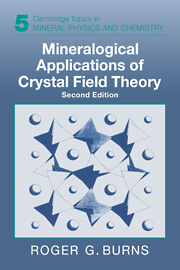Book contents
- Frontmatter
- Contents
- Preface to the first edition
- Preface to the second edition
- 1 Introduction
- 2 Outline of crystal field theory
- 3 Energy level diagrams and crystal field spectra of transition metal ions
- 4 Measurements of absorption spectra of minerals
- 5 Crystal field spectra of transition metal ions in minerals
- 6 Crystal chemistry of transition metal-bearing minerals
- 7 Thermodynamic properties influenced by crystal field energies
- 8 Trace element geochemistry: distribution of transition metals in the Earth's crust
- 9 Mantle geochemistry of the transition elements: optical spectra at elevated temperatures and pressures
- 10 Remote-sensing compositions of planetary surfaces: applications of reflectance spectra
- 11 Covalent bonding of the transition elements
- Appendices
- References
- Subject index
1 - Introduction
Published online by Cambridge University Press: 23 November 2009
- Frontmatter
- Contents
- Preface to the first edition
- Preface to the second edition
- 1 Introduction
- 2 Outline of crystal field theory
- 3 Energy level diagrams and crystal field spectra of transition metal ions
- 4 Measurements of absorption spectra of minerals
- 5 Crystal field spectra of transition metal ions in minerals
- 6 Crystal chemistry of transition metal-bearing minerals
- 7 Thermodynamic properties influenced by crystal field energies
- 8 Trace element geochemistry: distribution of transition metals in the Earth's crust
- 9 Mantle geochemistry of the transition elements: optical spectra at elevated temperatures and pressures
- 10 Remote-sensing compositions of planetary surfaces: applications of reflectance spectra
- 11 Covalent bonding of the transition elements
- Appendices
- References
- Subject index
Summary
The simplicity and convenience of crystal field theory have earned it a place in the ‘toolbox’ of the (geo)chemist.
F. A. Cotton, G. Wilkinson & P. L. Gauss, Basic Inorganic Chemistry, 2nd edn, p. 384 (1988)Crystal field theory is one of several chemical bonding models and one that is applicable solely to the transition metal and lanthanide elements. The theory, which utilizes thermodynamic data obtained from absorption bands in the visible and near-infrared regions of the electromagnetic spectrum, has met with widespread applications and successful interpretations of diverse physical and chemical properties of elements of the first transition series. These elements comprise scandium, titanium, vanadium, chromium, manganese, iron, cobalt, nickel and copper. The position of the first transition series in the periodic table is shown in fig. 1.1. Transition elements constitute almost forty weight percent, or eighteen atom percent, of the Earth (Appendix 1) and occur in most minerals in the Crust, Mantle and Core. As a result, there are many aspects of transition metal geochemistry that are amenable to interpretation by crystal field theory.
Cosmic abundance data for the transition elements (Appendix 1) show that each metal of the first transition series is several orders of magnitude more abundant than all of the metals of the second (Y–Ag) and third (Hf–Au) transition series, as well as the rare earth or lanthanide series (La–Lu). Iron, Fe, is by far the predominant transition element, followed by Ni, Cr and Mn. Crustal abundance data also show high concentrations of Fe relative to the other first-series transition elements on the Earth's surface.
- Type
- Chapter
- Information
- Publisher: Cambridge University PressPrint publication year: 1993



